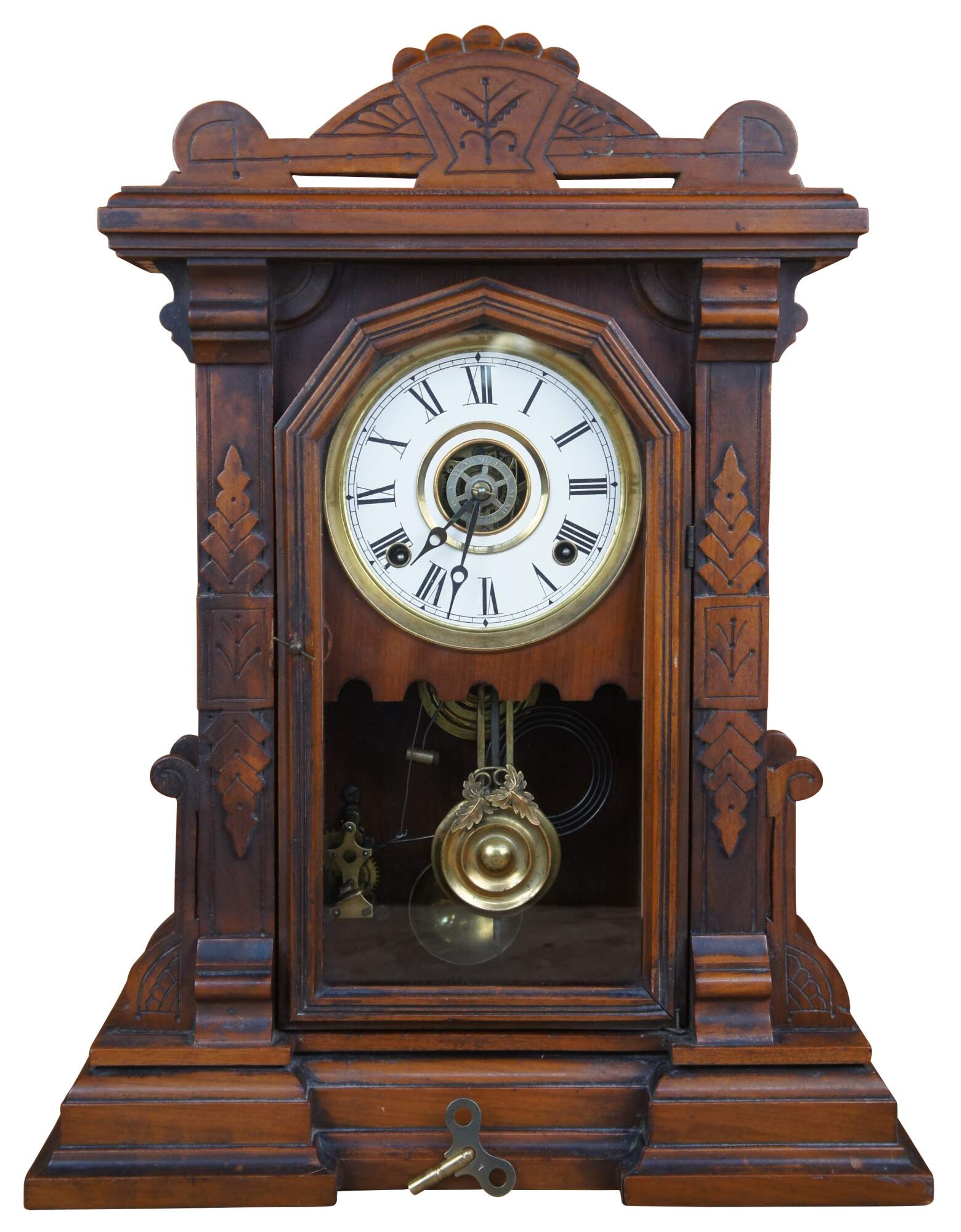
Shipping:
Free Shipping Included
Delivery:
Estimated 2-15 Business Days
Payments:
Credit Card, Check, Cash, PayPal, Apple Pay, Venmo
Returns:
30 Days 100% Money Back Guarantee, Buyer Pays Return Shipping
Description
Antique Victorian Eastlake E Ingraham (Bristol Connecticut) shelf or mentel clock. Made of walnut featuring Eastlake styling with pierced crown and roman numeral face.
Elias Ingraham (1805–1885) was born in Marlborough, CT, and became a famous clock case maker and designer. In 1828 he came to Bristol, CT to design and make clock cases for George Mitchell, a successful merchant of wooden movement clocks. Mitchell’s business was suffering because his major product, the pillar & scroll clock, was loosing popularity because of Jerome’s new bronze looking glass clock. Ingraham designed a case having carved mahogany columns, carved lion paw feet, corned blocks with rosettes over the columns, and a carved splat on top. In 1830 Ingraham went to work for Chauncey and Lawson Ives and designed the “triple decker” case. From 1832–1843, Ingraham was involved in various ventures in making clocks and furniture.
In 1843 Ingraham, his brother Andrew, and Elisha C. Brewster formed the firm Brewster & Ingrahams. This firm was the largest clock manufacturer in Bristol for nearly a decade. They specialized in spring driven clocks, using brass mainsprings in the earlier years. They introduced two of Ingraham’s most popular designs, the Round Gothic (beehive) and Sharp Gothic (steeple). In 1852 the Ingraham brothers formed E. & A. Ingraham & Company. Their factory was destroyed by fire in Dec. 1855 and the company went into bankruptcy in Dec. 1856.
In spring 1857 Ingraham started a new company, Elias Ingraham & Company. In 1857 Ingraham was granted his first two patents, the first for his Arch Column case design, produced for about 15 years. The second was for clock doors consisting of two circular bezels with a pair of decorative rosettes between them. This was the basic design for the Venetian, Doric and Ionic models, and was so popular that it was copied and changed slightly by many other clock companies. For the three years of this firm‘s existence, they made cases, and purchased movements, mostly from Waterbury and Noah Pomeroy.
Around January 1860, E. Ingraham & Company was formed. In 1865 they set up a shop to produce their own movements. By 1865 the basic models were the Venetian, Doric, Ionic and Grecian, with lever movement gallery clocks added in 1869. Until 1880 most new models were variations on these designs. In 1881 the first dramatic model change took place, with the introduction of walnut kitchen clocks, black mantel clocks, nickel alarm clocks and carriage clocks.
In July 1880 they incorporated as The E. Ingraham & Company, and became The E. Ingraham Company in 1884. This later name was used until 1958 when the name was changed to The Ingraham Company.
From 1885 to 1930 the black mantel clock was extensively produced. Oak kitchen clocks were introduced in 1891, and electric clocks in 1931. They started producing non-jewelled watches in 1914. Pendulum clocks were discontinued in 1942, and after the war, the company successfully produced alarm clocks, electric clocks, and non-jewelled watches up into the 1960‘s.
Condition
Good overall, marks/wear to wood
Dimensions
16" x 5.25" x 21"h